Abstract
Sustainable bio-based epoxy technology is developed by using bio-based epoxy materials instead of conventional fossil-derived ones. Significant progress in new bio-based epoxy material development on bio-based epoxy resins, curing agents, and additives, as well as bio-based epoxy formulated products, has been achieved recently not only in fundamental academic studies but also in industrial product development. There are mainly two types of bio-based epoxy resins: conventional epoxy resins and novel epoxy resins, depending on the epoxy resin building-block type used. Bio-based conventional epoxy resins are prepared by using the bio-based epichlorohydrin to replace conventional fossil-based epichlorohydrin. Bio-based novel epoxy resins are usually prepared from epoxidation of renewable precursors such as unsaturated vegetable oils, saccharides, tannins, cardanols, terpenes, rosins, and lignin. Typical bio-based curing agents are bio-based polyamines, polyamides, amidoamines, and cardanol-based phenalkamine-type curing agents. Cardanol is a typical bio-based reactive additive available commercially. Certain types of partially bio-based formulated epoxy products have been developed and supplied for use in bonding, coating, casting, composite, and laminating applications.
1. Introduction
Epoxy resin forms very strong and durable bonds with most materials and is the most important thermoset, widely used as a coating, adhesive, and composite in various applications ranging from consumer goods, general industry, construction and building, electrical and electronics assembly, wind energy, and automobile production to aerospace and the defense market [1,2,3,4,5,6,7,8,9,10]. Epoxy systems are typically formulated in the form of a compound containing epoxy resin and a curing agent with modifiers and additives. Most of these epoxy resins, curing agents, and reactive additives used today still originate from fossil fuels.
Sustainable epoxy technology development has become more and more important nowadays to meet the expectations from global environmental protection, government regulation restriction, and customer requirements, focusing mainly on health and safety improvement, energy saving, and circular economy contribution [11,12,13,14,15,16,17,18]. Sustainable bio-based epoxy technology is developed primarily for circular economy contribution by using bio-based epoxy materials instead of conventional fossil-derived ones. Significant progress in new epoxy material development on bio-based epoxy resins, epoxy curing agents, and additives, as well as epoxy formulations, has been achieved recently not only in fundamental academic studies but also in industrial product development. The latest developments in fundamental academic studies have been introduced and reviewed very well [19,20,21,22,23,24,25], while the actual status in their industrial uses cannot be found easily in literature. Recent progress in bio-based epoxy technology development, with a focus on actual successful industrial uses, is introduced and summarized in this review article.
A bio-based material is a product whose raw materials are obtained entirely or partially from biomass. There are two methods for the bio-based content determination: the bio-based content and the bio-based carbon content. The bio-based content refers to the proportion of biomass in a product, taking into account the four main elements: carbon, hydrogen, oxygen, and nitrogen. The bio-based carbon content focuses solely on carbon and is generally expressed as a percentage of the carbon (organic carbon to total carbon) contained in the product. The bio-based carbon content is commonly used in epoxy technology to represent its bio content. The determination of the bio-based carbon content is carried out according to ASTM D6866 [26] and EN 16640 [27]. Bio-based carbon originating from biomass is radioactive, whereas carbon originating from fossils no longer is. The content of radioactive carbon and thus the bio-based carbon content can be determined and calculated using Accelerator Mass Spectrometry (AMS).
2. Bio-Based Epoxy Resins
There are mainly two types of bio-based epoxy resins available commercially or under commercial investigation: conventional epoxy resins and novel epoxy resins, depending on the epoxy resin building-block type used. Bio-based conventional epoxy resins are prepared by simply using the bio-based epichlorohydrin to replace conventional fossil-based epichlorohydrin in reaction with the same conventional building-block chemicals. Typical bio-based conventional epoxy resins are bio-based bisphenol A epoxy resins, bisphenol F epoxy resins, phenol novalac epoxy resins, and glycidyl amine-based epoxy resins. Since their preparation method and chemical structure are the same as those of conventional epoxy resins, bio-based conventional epoxy resins can be easily used in actual applications with no big concerns regarding its performance change. Bio-based novel epoxy resins are usually produced from the epoxidation of renewable precursors such as unsaturated vegetable oils, saccharides, tannins, cardanols, terpenes, rosins, and lignin [28,29,30,31,32,33,34,35,36,37,38,39,40,41,42]. Typical bio-based novel epoxy resins are vegetable-oil-based epoxy resins, cardanol-based epoxy resins, rosin-based epoxy resins, sorbitol- or isosorbide-based epoxy resins, lignin-based epoxy resins, and furan-based epoxy resins.
2.1. Bio-Based Epichlorohydrin
The majority of commercial epoxy resins are glycidyl-type epoxy resins synthesized by the reaction of active hydrogen in phenols, alcohols, amines, and acids with epichlorohydrin at certain well-controlled conditions. Most of these chemicals, including epichlorohydrin, originate from fossil fuels. Conventional epichlorohydrin is prepared by the reaction of propylene, originating from petroleum as well known, and chlorine. Recently, 100% bio-based epichlorohydrin has been developed and successfully commercialized. The bio-based epichlorohydrin is synthesized by the reaction of hydrochloric acid with renewable glycerol derived from vegetable oil as a byproduct in the preparation of biodiesel and oleochemical products. The preparation method of conventional fossil-based and new bio-based epichlorohydrin is shown in Figure 1 [43]. The bio-based epichlorohydrin has been used to replace conventional fossil-based epichlorohydrin in the commercial production of bio-based epoxy resins.

Figure 1.
Preparation of bio-based and fossil-based epichlorohydrin.
2.2. Bio-Based Conventional Epoxy Resins
Bio-based conventional epoxy resins are typically glycidyl-type epoxy resins prepared using the bio-based epichlorohydrin to replace conventional fossil-based epichlorohydrin. Bio-based bisphenol A epoxy resin is prepared by the reaction of bisphenol A and bio-based epichlorohydrin, as shown in Figure 2 [44]. Th bio-based carbon content of standard-grade liquid bisphenol A epoxy resin is around 28%. The bio-based carbon content, EEW (epoxide equivalent weight), and viscosity of typical bio-based conventional epoxy resins are summarized in Table 1. These bio-based conventional epoxy resins have been commercially produced and supplied by several epoxy resin manufacturers [45,46,47]. Since their preparation method and chemical structure are the same as those of normal epoxy resin, bio-based conventional epoxy resins can be easily used in actual applications with no big concerns about its performance change. The preparation of 100% bio-based conventional epoxy resins, however, is a big challenge at the current stage as the resin building-block parts, such as bisphenol A, can only be produced from fossil sources.

Figure 2.
Synthesis of bisphenol A epoxy resin.

Table 1.
Typical bio-based conventional epoxy resins.
2.3. Bio-Based Novel Epoxy Resins
Bio-based novel epoxy resins are usually produced from epoxidation of renewable precursors, such as unsaturated vegetable oils, saccharides, tannins, cardanols, terpenes, rosins, and lignin. Bio-based epoxy resins available commercially or under commercial investigation include vegetable-oil-based epoxy resins, cardanol-based epoxy resins, rosin-based epoxy resins, isosorbide-based epoxy resins, lignin-based epoxy resins, and furan-based epoxy resins [48,49]. Typical bio-based novel epoxy resins, their biomass source, and product available status are summarized in Table 2.

Table 2.
Typical bio-based novel epoxy resins.
2.3.1. Vegetable-Oil-Based Epoxy Resins
Vegetable-oil-based epoxy resins have been commercialized and supplied by several epoxy resin manufacturers [50,51,52,53,54]. By combination use of bio-based epichlorohydrin for product preparation, these vegetable-oil-based epoxy resins are real renewable materials with a maximum of 100% bio-based carbon content achievement. Typical commercialized vegetable-oil-based epoxy resins, their biomass source, EEW, and viscosity are summarized in Table 3.

Table 3.
Typical vegetable-oil-based epoxy resins.
Glycidyl ether of C12–C14 alcohol, derived from palm oil, has very low viscosity and is mainly used as a diluent. Its chemical structure is shown in Figure 3.
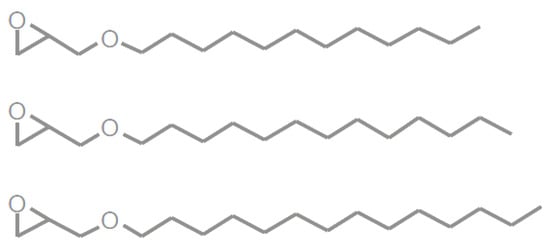
Figure 3.
Chemical structure of glycidyl ether of C12–C14 alcohol.
Triglycidyl ether of castor oil, derived from castor oil, is a tri-functional epoxy resin and can be used to improve flexibility and toughness. Its chemical structure is shown in Figure 4.
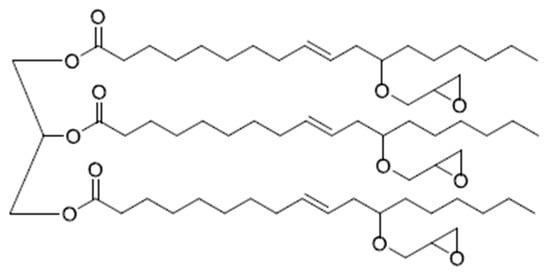
Figure 4.
Chemical structure of triglycidyl ether of castor oil.
Triglycidyl ether of polyglycerol, derived also from palm oil, is a tri-functional epoxy resin and can be used to improve flexibility and toughness. Its chemical structure is shown in Figure 5.
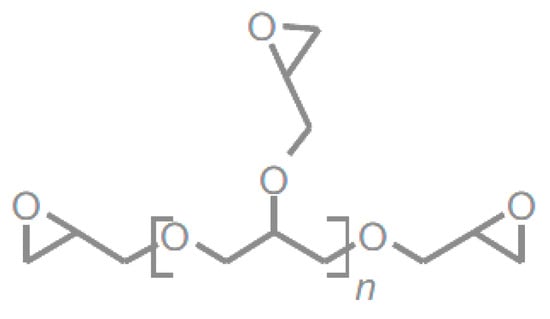
Figure 5.
Chemical structure of triglycidyl ether of polyglycerol.
Glycidyl ether of dimeric acid, derived from tall oil, was commercialized a long time ago and has been used mainly to improve flexibility and toughness. Its chemical structure is shown in Figure 6.
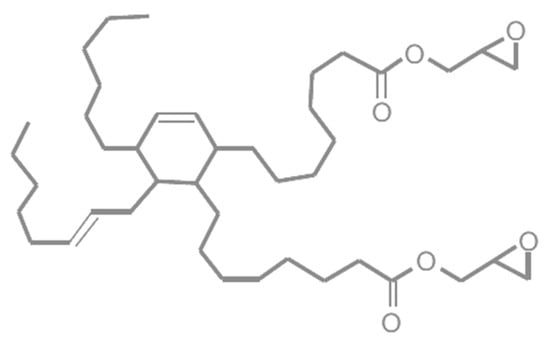
Figure 6.
Chemical structure of glycidyl ether of dimeric acid.
2.3.2. Cardanol-Based Epoxy Resins
Cardanol is a phenolic liquid, derived from biomass cashew nuts. It is the main component of cashew nutshell liquid (CNSL) (https://en.wikipedia.org/wiki/Cashew_nutshell_liquid (accessed on 17 December 2024) Cardanol-based epoxy resins are produced by the reaction of cardanol with epichlorohydrin, and their bio-based carbon content can achieve 100%. Mono-functional, di-functional, and multi-functional cardanol-based epoxy resins have been commercialized by Cardolite Corporation [55]. Mono-functional cardanol-based epoxy resin has relatively low viscosity and can be used as a diluent. The chemical structure of cardanol-based epoxy resin is shown in Figure 7.
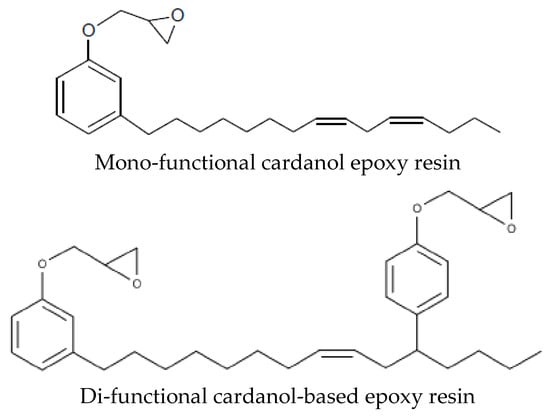
Figure 7.
Chemical structure of cardanol-based epoxy resin.
2.3.3. Rosin-Based Epoxy Resins
Rosin is a biomass solid material derived via bio-refinery from pine trees and other plants, such as conifers. Rosin contains resin acids, especially abietic aid. Rosin-based epoxy resin is a glycidyl-ester-type epoxy resin, prepared by the reaction of rosin acid with epichlorohydrin. Its bio-based carbon content can achieve nearly 100% with the use of bio-based epichlorohydrin. Rosin-based epoxy resins have been commercialized by Ingevity Corporation [56]. The chemical structure of tri-functional rosin-based epoxy resin is shown in Figure 8.
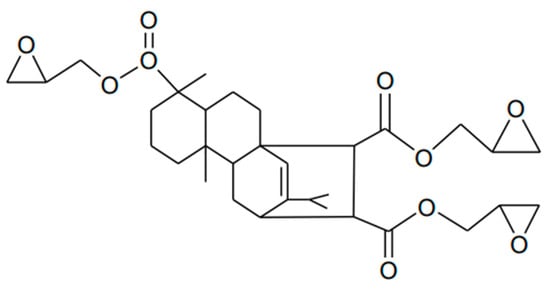
Figure 8.
Chemical structure of tri-functional rosin-based epoxy resin.
2.3.4. Sorbitol, Isosorbide-Based Epoxy Resins
Sorbitol is a sugar alcohol, derived from the glucose in saccharides of biomass potato starch and corn starch. Isosorbide is prepared by the dehydration of sorbitol, as shown in Figure 9 [57].

Figure 9.
Preparation scheme of sorbitol and isosorbide from starch biomass.
Sorbitol-based epoxy resin can be prepared by the reaction of sorbitol with epichlorohydrin. Its bio-based carbon content can achieve nearly 100% by combination use of bio-based epichlorohydrin in the production. Sorbitol-based epoxy resin has been commercialized and supplied by several epoxy resin suppliers [58,59,60,61]. It is a multi-functional glycidyl-ether-type epoxy resin. The typical chemical structure of sorbitol-based epoxy resin is shown in Figure 10.
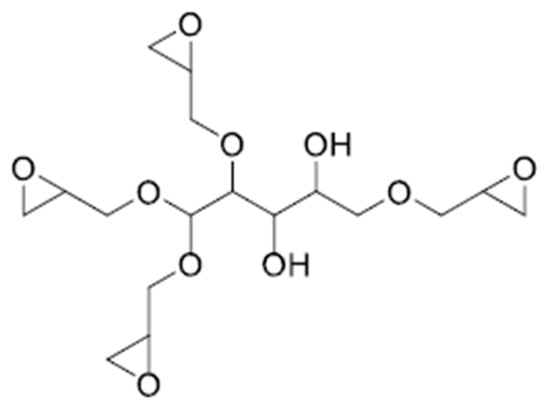
Figure 10.
Chemical structure of sorbitol-based epoxy resin.
Isosorbide-based epoxy resin can be prepared by the reaction of isosorbide with epichlorohydrin. Its bio-based carbon content can also achieve nearly 100% by combination use of bio-based epichlorohydrin in the production. Isosorbide-based epoxy resin has been commercialized and supplied by several epoxy resin suppliers [62,63]. It is a di-functional glycidyl-ether-type epoxy resin and can potentially be used as a base resin because of a relatively strong building-block structure. Typical chemical structure of isosorbide-based epoxy resin is shown in Figure 11.
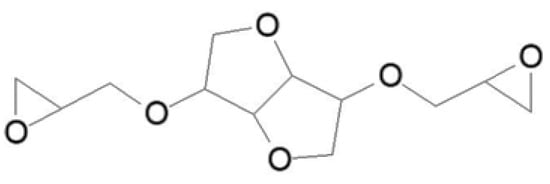
Figure 11.
Chemical structure of isosorbide-based epoxy resin.
2.3.5. Lignin-Based Epoxy Resins
Lignin is one of the three main components of wood, together with cellulose and hemi-cellulose. Chemically, lignin is a polymer comprising cross-linked phenolic precursors. It is the second-most abundant biopolymer only behind cellulose and is the most abundant bio-aromatic compound [64]. Lots of studies have been carried out to prepare lignin-based epoxy resin and investigate its properties and performance, aiming to establish a useful level of bio-replacement on bisphenol A in epoxy resin technology [65,66,67,68,69,70,71]. Commercial preparation of bio-based lignin-based epoxy resins, however, is still at an early investigation stage, due to the complex structure of lignin material. Figure 12 illustrates one preparation route of lignin-based epoxy resin, synthesized by the reaction of lignin’s phenolic hydroxy group with epichlorohydrin [72].

Figure 12.
Preparation scheme of lignin-based epoxy resin.
2.3.6. Furan-Based Epoxy Resins
As illustrated in Figure 13, furfural compounds can be prepared from cellulose, the most abundant natural biopolymer derived from various plants. Furan-based epoxy resin can be prepared by the reaction of alcohol or acid furan compounds with epichlorohydrin. The maximum bio-based carbon content can achieve 100% with combination use of bio-based epichlorohydrin. Great efforts have been paid to develop and investigate furan-based epoxy resins, as they are potentially expected to replace fossil-derived bisphenol A due to its aromatic chrematistics [73,74,75,76,77]. Figure 14 shows the chemical structure of two di-functional furan-based epoxy resins.
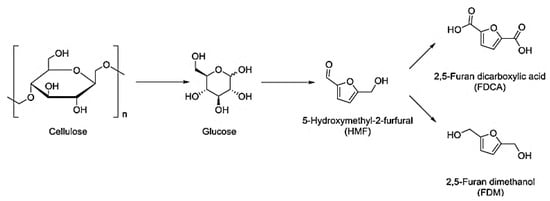
Figure 13.
Preparation scheme of acid and alcohol furan.
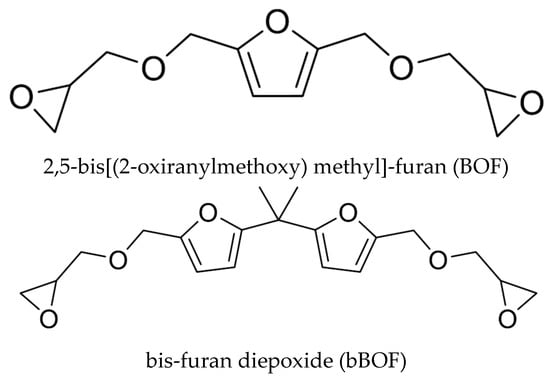
Figure 14.
Chemical structure of furan-based epoxy resins.
3. Bio-Based Epoxy Curing Agents and Additives
Typical bio-based curing agents available commercially or under commercial investigation are bio-based polyamines, bio-based polyamides, bio-based amidoamines, cardanol-based phenalkamine-type curing agents [78,79,80,81,82,83,84,85,86,87,88,89]. IPDA (isophoronediamine), furan-based amine, and isosorbide-based amine curing agents are typical bio-based polyamine-type curing agents. Cardanol is a typical bio-based reactive additive.
3.1. Bio-Based Polyamine-Type Curing Agents
The majority of commercial polyamine-type curing agents are prepared from chemicals that originated from fossil fuels. Only a few of them are prepared from biomass material. As summarized in Table 4, IPDA, furan-based amine curing agents, and isosorbide-based amine curing agents are typical bio-based polyamine curing agents available commercially or under commercial investigation [90,91,92].

Table 4.
Typical bio-based polyamine-type curing agents.
IPDA is one typical cycloaliphatic diamine-type curing agent offering low viscosity, good color stability, and high Tg suitable for high-temperature high-humidity-resistant applications. IPDA is prepared from isophorone, which is commercially obtained exclusively via the self-condensation of acetone. With the use of bio-based acetone derived from the fermentation of biomass material such as starch and glucose, up to 90% bio-based carbon content of IPDA has been commercialized. The chemical structure of IPDA is shown in Figure 15.
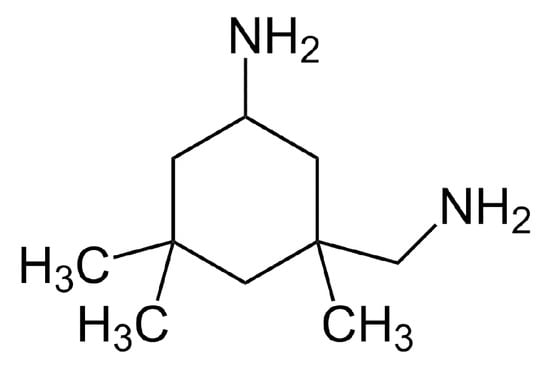
Figure 15.
Chemical structure of IPDA (isophoronediamine).
Furan-based amine curing agents can be prepared by the amination reaction of alcohol furan compounds with ammonia. The maximum bio-based carbon content can achieve nearly 100%. Figure 16 shows the chemical structure of [5-(aminomethyl)furan-2-yl]methanamine, a furan-based diamine.

Figure 16.
Chemical structure of [5-(aminomethyl)furan-2-yl]methanamine.
Isosorbide-based polyamine-type curing agents can be prepared by the amination reaction of isosorbide with ammonia. Its bio-based carbon content can also achieve nearly 100%. Figure 17 shows the chemical structure of diaminoisosorbide, an isosorbide-based diamine.
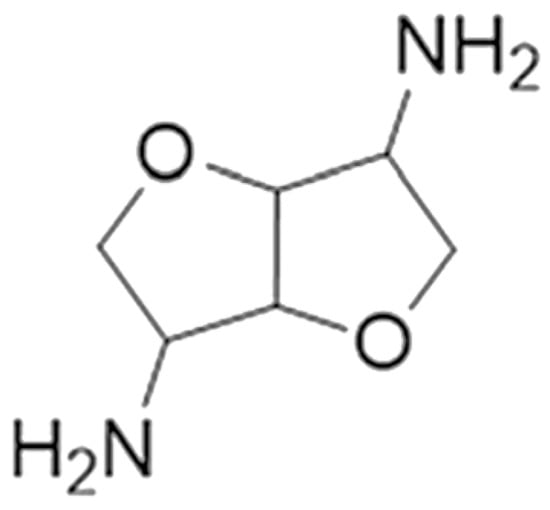
Figure 17.
Chemical structure of diaminoisosorbide.
3.2. Bio-Based Polyamide-Type Curing Agents
Polyamide-type curing agents are prepared by the reaction of dimeric acid, derived from biomass tall oil, with excessive polyamine, as illustrated in Figure 18 [93]. Polyamide has higher viscosity, lower toxicity, and longer pot-life than polyamines. Polyamide curing agents show good adhesion, good flexibility, and toughness. Up to 70% bio-based carbon content can be achieved depending on the addition ratio of dimeric acid applied in its synthesis [94,95].
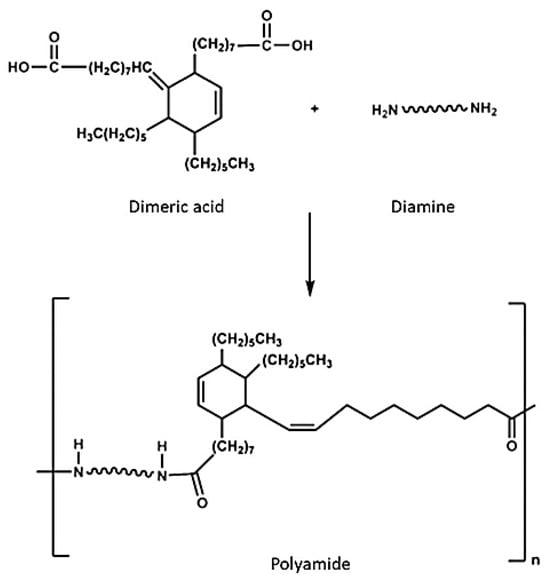
Figure 18.
Preparation of polyamide-type curing agent.
3.3. Bio-Based Amidoamine-Type Curing Agents
Amidoamine-type curing agents are prepared by the reaction of monobasic fatty carboxylic acid, derived from biomass vegetable oil, with excessive polyamine. Amidoamine has viscosity between polyamide and polyamine. Amidoamine-type curing agents show good handling property, good adhesion, and good chemical resistance. Up to 60% bio-based carbon content can be achieved depending on the addition ratio of fatty acid applied in its synthesis.
3.4. Bio-Based Phenalkamine-Type Curing Agents
Bio-based phenalkamine is a Mannich reaction product of polyamine with biomass-derived cardanol, and aldehyde, as illustrated in Figure 19 [96,97]. Bio-based phenalkamine-type curing agents offer fast curability and good chemical resistance. Up to nearly 90% bio-based carbon content can be achieved depending on the addition ratio of cardanol applied in its synthesis.
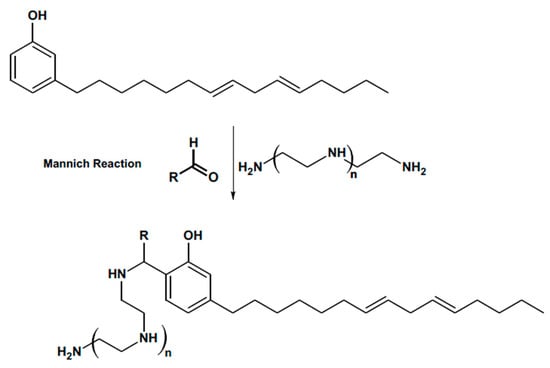
Figure 19.
Preparation of bio-based phenalkamine.
3.5. Bio-Based Phenols
Cardanol is a 100% bio-based phenol, prepared by decarboxylated and distilled from cashew nutshell liquid, a renewable biomass as already described previously. Cardanol can be used as a reactive additive in epoxy formulation as one alternative to replace nonylphenol [98], a chemical with a high level of health and safety concerns. The hemical structure of cardanol is shown in Figure 20.

Figure 20.
Chemical structure of cardanol.
4. Bio-Based Formulated Epoxy Materials
Bio-based epoxy materials are formulated by using, either partially or entirely, bio-based epoxy resins, bio-based curing agents, or bio-based additives to replace conventional fossil-derived raw materials [99,100,101,102,103,104,105,106,107,108,109]. Commercial bio-based formulated epoxy products have been already developed and supplied for bonding, coating, casting, composite, and laminating applications by several manufacturers. Table 5 lists a few bio-based formulated epoxy products available commercially, their product type, bio-based carbon content range, and target applications [110,111,112,113,114].

Table 5.
Bio-based formulated epoxy products.
5. Conclusions
Significant progress in sustainable bio-based epoxy technology development has been achieved in recent years. Many bio-based epoxy resins, bio-based curing agents and additives, and bio-based formulated epoxy materials, as well as their performance, have been investigated. More importantly, certain types of bio-based epoxy resins, bio-based curing agents, and bio-based formulated epoxy products have been commercialized, and their use in actual applications has been realized. Continuous efforts in bio-based epoxy technology development have become increasingly important to realize a real sustainable and environmentally friendly society.
Funding
This research received no external funding.
Data Availability Statement
The original contributions presented in this study are included in the article. Further inquiries can be directed to the author.
Conflicts of Interest
Author was employed by the Henkel Japan Ltd. The remaining author declare that the research was conducted in the absence of any commercial or financial relationships that could be construed as a potential conflict of interest. The Henkel Japan Ltd. had no role in the design of the study; in the collection, analyses, or interpretation of data; in the writing of the manuscript, or in the decision to publish the results.
References
- Kakiuchi, H. Epoxy Resin: A Review; The Japan Society of Epoxy Resin Technology: Tokyo, Japan, 2003. [Google Scholar]
- Panda, H. Epoxy Resins Technology Handbook; Asia Pacific Business Press: New Delhi, India, 2016. [Google Scholar]
- Lewis, A.F. Epoxy resin adhesives. In Epoxy Resins—Chemistry and Technology, 2nd ed.; May, C.A., Ed.; Marcel Dekker: New York, NY, USA, 1988; pp. 653–718. [Google Scholar]
- Vidil, T.; Tournilhac, F.; Musso, S.; Robisson, A.; Leibler, L. Control of reactions and network structures of epoxy thermosets. Prog. Polym. Sci. 2016, 62, 126–179. [Google Scholar] [CrossRef]
- Kwakernaak, A.; Hofstede, J.; Poulis, J.; Benedictus, R. Improvements in bonding metals for aerospace and other applications. In Welding and Joining of Aerospace Materials; Chaturvedi, M., Ed.; Woodhead Publishing: Oxford, UK, 2012; pp. 235–319. [Google Scholar]
- Petrie, E.M. Handbook of Adhesives and Sealants; MicGraw-Hill: New York, NY, USA, 2006; pp. 355–373. [Google Scholar]
- Chen, C. Epoxy adhesive technology: Latest developments and new trend. In Progress in Adhesion and Adhesives; Mittal, K., Ed.; Wiley—Scrivener: Beverly, MA, USA, 2024; Volume 8, pp. 251–284. [Google Scholar]
- Chen, C. Structural epoxy adhesives. In Structural Adhesives: Properties, Characterization and Applications; Mittal, K.L., Panigraphi, S.K., Eds.; Wiley—Scrivener: Beverly, MA, USA, 2023; pp. 3–30. [Google Scholar]
- Cordes, E.H. Adhesives in the automotive industry. In Handbook of Adhesive Technology, 2nd ed.; Pizzi, A., Mittal, K.L., Eds.; CRC Press: Boca Raton, FL, USA, 2003; pp. 983–999. [Google Scholar]
- Chen, C.; Li, B.; Kanari, M.; Lu, D. Epoxy adhesives. In Adhesives and Adhesive Joints in Industry Applications; Rudawska, A., Ed.; IntechOpen: London, UK, 2019; pp. 37–49. [Google Scholar]
- Cailoll, S.; Boutevin, B.; Pascault, J. Bio-sourced epoxy monomer and polymers. In Handbook of Adhesive Technology, 3rd ed.; Pizzi, A., Mittal, K.L., Eds.; CRC Press: Boca Raton, FL, USA, 2018; pp. 443–470. [Google Scholar]
- Heinrich, L.A. Future opportunities for bio-based adhesives—Advantages beyond renewability. Green Chem. 2019, 21, 1866–1888. [Google Scholar] [CrossRef]
- Roudsari, G.M.; Mohanty, A.K.; Misra, M. Green approaches to engineer tough biobased epoxies: A review. ACS Sustain. Chem. Eng. 2017, 5, 9528–9541. [Google Scholar] [CrossRef]
- Rijk, R.; Veraart, R. Global Legislation for Food Packaging Materials; Wiley—VCH: Weinheim, Germany, 2010; pp. 13–15. [Google Scholar]
- Hase, E.; Kitano, M. The role and place of risk assessment in chemical management especially in Japan, Europe and U.S.A. Jpn. J. Risk Anal. 2012, 22, 63–72. [Google Scholar]
- Vijayan, P.; Formela, K.; Saeb, M.; Chithra, P.; Thomas, S. Integration of antifouling properties into epoxy coatings: A review. J. Coat. Technol. Res. 2022, 19, 269–284. [Google Scholar] [CrossRef]
- Packham, D.E. The environmental impact of adhesives. In Eco-Efficient Construction and Building Materials Life Cycle Assessment (LCA), Eco-Labelling and Case Studies; Pacheco-Torgal, F., Cabeza, L.F., Labrincha, J., Magalhiies, A., Eds.; Woodhead Publishing: Cambridge, UK, 2014; pp. 338–367. [Google Scholar]
- Hemmila, V.; Adamopoulos, S.; Karlsson, O.; Kumar, A. Development of sustainable bio-adhesives for engineered wood panels—A review. RSC Adv. 2017, 7, 38604–38630. [Google Scholar] [CrossRef]
- Zhang, Y.; Liu, X.; Wan, M.; Zhu, Y.; Zhang, K. From renewable biomass to bio-based epoxy monomers and bio-based epoxy curing agents: Synthesis and performance. Polym. Degrad. Stab. 2024, 229, 110988. [Google Scholar] [CrossRef]
- Krishnakumar, B.; Pucci, A.; Wadgaonkar, P.P.; Kumar, I.; Binder, W.H.; Rana, S. Vitrimers based on bio-derived chemicals: Overview and future prospects. Chem. Eng. J. 2022, 433, 133261. [Google Scholar] [CrossRef]
- Sreehari, H.; Gopika, V.; Jayan, J.; Sethulekshmi, A.; Saritha, A. A comprehensive review on bio epoxy based IPN: Synthesis, properties and applications. Polymer 2022, 252, 124950. [Google Scholar] [CrossRef]
- Marriam, F.; Irshad, A.; Umer, I.; Asghar, M.; Atif, M. Vegetable oils as bio-based precursors for epoxies. Sustain. Chem. Pharm. 2023, 31, 100935. [Google Scholar] [CrossRef]
- Zhang, Y.; Liu, X.; Wan, M.; Zhu, Y.; Zhang, K. Recent development of functional bio-based epoxy resins. Molecules 2024, 29, 4428. [Google Scholar] [CrossRef] [PubMed]
- Capretti, M.; Giammaria, V.; Santulli, C.; Boria, S.; Bianco, G. Use of bio-epoxies and their effect on the performance of polymer composites: A critical review. Polymers 2023, 15, 4733. [Google Scholar] [CrossRef]
- Zhao, W.; Liu, J.; Wang, S.; Dai, J.; Liu, X. Bio-based thermosetting resins: From molecular engineering to intrinsically multifunctional customization. Adv. Mater. 2024, 36, 2311242. [Google Scholar] [CrossRef] [PubMed]
- ASTM D6866; Standard Test Methods for Determining the Biobased Content of Solid, Liquid, and Gaseous Samples Using Radiocarbon Analysis. ASTM International: West Conshohocken, PA, USA, 2016.
- EN 16640; Determination of the Bio-Based Carbon Content Using the Radiocarbon Method. European Committee for Standardization: Brussels, Belgium, 2017.
- Santosh, E.; Yadav, K.; Palmese, G.R.; Stanzione, J.F. Recent advances in bio-based epoxy resins and bio-based epoxy curing agents. J. Appl. Polym. Sci. 2016, 133, 44103. [Google Scholar]
- Auvergne, R.; Caillol, S.; David, G.; Boutevin, B.; Pascault, J. Biobased thermosetting epoxy: Present and future. Chem. Rev. 2014, 114, 1082–1115. [Google Scholar] [CrossRef]
- Hambleton, K.; Stanzione, J. Synthesis and characterization of a low-molecular-weight novolac epoxy derived from lignin-inspired phenolics. ACS Omega 2021, 6, 23855–23861. [Google Scholar] [CrossRef] [PubMed]
- Wang, Z.; Gnanasekar, P.; Nair, S.; Yi, S.; Yan, N. Curing behavior and thermomechanical performance of bio-epoxy resin synthesized from vanillyl alcohol: Effects of the curing agent. Polymers 2021, 13, 2891. [Google Scholar] [CrossRef]
- Aziz, T.; Fan, H.; Zhang, X.; Khan, F.; Fahad, S.; Ullah, A. Adhesives properties of bio-based epoxy resin reinforced by cellulose nanocrystal additives. J. Polym. Eng. 2019, 40, 314–320. [Google Scholar] [CrossRef]
- Ruiz, Q.; Pourchet, S.; Placet, V.; Plasseraud, L.; Boni, G. New eco-friendly synthesized thermosets from isoeugenol-based epoxy resin. Polymers 2019, 12, 229. [Google Scholar] [CrossRef]
- Song, X.; Deng, Z.; Li, C.; Song, F.; Wang, X.; Chen, L.; Guo, D.; Wang, Y. A bio-based epoxy resin derived from p-hydroxycinnamic acid with high mechanical properties and flame retardancy. Chin. Chem. Lett. 2022, 33, 4912–4917. [Google Scholar] [CrossRef]
- Gonçalves, F.A.M.M.; Ferreira, P.; Alves, P. Synthesis and characterization of itaconic-based epoxy resin: Chemical and thermal properties of partially biobased epoxy resins. Polymer 2021, 235, 124285. [Google Scholar] [CrossRef]
- Chong, K.L.; Lai, J.C.; Rahman, R.A.; Adrus, N.; Al-Saffar, Z.H.; Hassan, A.; Lim, T.H.; Wahit, M.U. A review on recent approaches to sustainable bio-based epoxy vitrimer from epoxidized vegetable oils. Ind. Crops Prod. 2022, 189, 115857. [Google Scholar] [CrossRef]
- Kalita, D.J.; Tarnavchyk, I.; Kalita, H.; Chisholm, B.J.; Webster, D.C. Novel bio-based epoxy resins from eugenol derived copolymers as an alternative to DGEBA resin. Prog. Org. Coat. 2023, 178, 107471. [Google Scholar] [CrossRef]
- Gaina, C.; Ursache, O.; Gaina, V.; Serban, A.; Asandulesa, M. Novel bio-based materials: From castor oil to epoxy resins for engineering applications. Materials 2023, 16, 5649. [Google Scholar] [CrossRef] [PubMed]
- Wang, M.; Liu, X.; Zhang, Y. Review of recyclable bio-based epoxy resins with dynamic chemical bonds. J. Chem. Eng. Res. Updates 2024, 11, 1–28. [Google Scholar]
- Ortiz, P.; Wiekamp, M.; Vendamme, R.; Eevers, W. Bio-based epoxy resins from bio-refinery byproducts. BioResources 2019, 14, 3200–3209. [Google Scholar] [CrossRef]
- Czub, P.; Sienkiewicz, A. Synthesis of bio-based epoxy resins. In Bio-Based Epoxy Polymers, Blends, and Composites: Synthesis, Properties, Characterization, and Applications; Parameswaranpillai, J., Rangappa, S.M., Siengchin, S., Jose, S., Eds.; Wiley-VCH: Weinheim, Germany, 2021; pp. 1–72. [Google Scholar]
- Ge, M.; Miao, J.; Liang, G.; Gu, A. Biobased epoxy resin with ultrahigh glass transition temperature over 400 °C by post-crosslinking strategy. Chem. Eng. J. 2024, 482, 148993. [Google Scholar] [CrossRef]
- Bio-Based Drop-In, Smart Drop-In and Dedicated Chemicals. Available online: https://roadtobio.eu/uploads/news/2017_October/RoadToBio_Drop-in_paper.pdf (accessed on 17 December 2024).
- Liu, J.; Bai, C.; Jia, D.; Liu, D.; He, F.; Liu, Q.; Yao, J.; Wang, X.; Wu, Y. Design and fabrication of a novel superhydrophobic surface based on a copolymer of styrene and bisphenol A diglycidyl ether monoacrylate. RSC Adv. 2014, 4, 18025–18032. [Google Scholar] [CrossRef]
- Spolchemie EnviPOXY Products. Available online: https://www.spolchemie.cz/en/ (accessed on 17 December 2024).
- Briozen Bio-Source Epoxy. Available online: https://www.tomo-e.co.jp/upload/newsJA/2C64F19-newsJA_content-033.pdf (accessed on 17 December 2024).
- Leuna Harze Biobased Epoxy Resins. Available online: https://leuna-harze.de/en/move-to-green/biobased-products#c2361 (accessed on 17 December 2024).
- Agbo, P.; Mali, A.; Deng, D.; Zhang, L. Bio-oil-based epoxy resins from thermochemical processing of sustainable resources: A short review. J. Compos. Sci. 2023, 7, 374. [Google Scholar] [CrossRef]
- Kumar, S.; Samal, S.; Mohanty, S.; Nayak, S. Recent development of biobased epoxy resins: A review. Polym. Plast. Technol. Eng. 2017, 57, 133–155. [Google Scholar] [CrossRef]
- Epotec RD 108G. Available online: https://www.tri-iso.com/documents/Epotec_RD-108G_TDS_pdf.pdf (accessed on 17 December 2024).
- Epotec RD 124. Available online: https://www.tri-iso.com/documents/Epotec_RD-124_TDS_pdf.pdf (accessed on 17 December 2024).
- Epotec RD 133. Available online: https://www.tri-iso.com/documents/Epotec_RD-133_TDS_pdf.pdf (accessed on 17 December 2024).
- Epotec YD 128. Available online: https://www.tri-iso.com/documents/Epotec_YD-128_TDS_pdf.pdf (accessed on 17 December 2024).
- Erysis GE-35. Available online: https://www.huntsman.com/docs/Documents/ERISYSGE-35_US_e.pdf (accessed on 17 December 2024).
- Ultra Lite CNSL Technology. Available online: https://www.cardolite.com/technology/ultra-lite-technology/ (accessed on 17 December 2024).
- Pioneering Sustainable Polymers. Available online: https://www.ingevity.com/altamer/ (accessed on 17 December 2024).
- Brandi, F.; Al-Naji, M. Sustainable sorbitol dehydration to isosorbide using solid acid catalysts: Transition from batch reactor to continuous-flow system. ChemSusChem 2022, 15, e202102525. [Google Scholar] [CrossRef]
- Erysis GE-60. Available online: https://www.huntsman.com/docs/Documents/Erisys-GE60_eur_e.pdf (accessed on 17 December 2024).
- Bio-Based Specialty Epoxies. Available online: https://nagaseamerica.com/product/green-denacol/ (accessed on 17 December 2024).
- Epotec RD 144. Available online: https://www.tri-iso.com/documents/Epotec_RD-144_TDS_pdf.pdf (accessed on 17 December 2024).
- Shibata, M.; Yoshihara, S.; Yashiro, M.; Ohno, Y. Thermal and mechanical properties of sorbitol-based Epoxy resin cured with quercetin and the biocomposites with wood flour. J. Appl. Polym. Sci. 2013, 2753–2758. [Google Scholar] [CrossRef]
- Lukaszczyk, J.; Janicki, B.; Kaczmarek, M. Synthesis and properties of isosorbide based epoxy resin. Eur. Poly. J. 2011, 47, 1601–1606. [Google Scholar] [CrossRef]
- Isosorbide Diglycidyl Ether. Available online: https://specificpolymers.com/product/isosorbide-diglycidyl-ether-bio-5/ (accessed on 17 December 2024).
- Bergamasco, S.; Zikeli, F.; Vinciguerra, V.; Sobolev, A.; Scarnati, L.; Tofani, G.; Mugnozza, G.; Romagnoli, M. Extraction and characterization of acidolysis lignin from turkey oak (Quercus cerris L.) and eucalypt (Eucalyptus camaldulensis Dehnh.) Wood from Population Stands in Italy. Polymers 2023, 15, 3591. [Google Scholar] [CrossRef]
- Gioia, C.; Colonna, M.; Tagami, A.; Medina, L.; Sevastyanova, O.; Berglund, L.A.; Lawoko, M. Lignin-based epoxy resins: Unravelling the relationship between structure and material properties. Biomacromolecules 2020, 21, 1920–1928. [Google Scholar] [CrossRef] [PubMed]
- Xu, C.; Ferdosian, F. Lignin-based epoxy resins. In Conversion of Lignin into Bio-Based Chemicals and Materials; Springer: Berlin/Heidelberg, Germany, 2017; pp. 111–131. [Google Scholar]
- Bagheri, S.; Nejad, M. Fully biobased composite made with epoxidized-lignin, reinforced with bamboo fibers. Polym. Compos. 2023, 44, 3926–3938. [Google Scholar] [CrossRef]
- Zhu, Y.; Li, Z.; Wang, X.; Ding, D.; Tian, Y. Preparation and application of lignin-based epoxy resin from pulping black liquor. ChemistrySelect 2020, 5, 3494–3502. [Google Scholar] [CrossRef]
- Tiz, D.; Vicente, F.; Kroflic, A.; Likozar, B. Lignin-based covalent adaptable network polymers—When bio-based thermosets meet recyclable by design. ACS Sustain. Chem. Eng. 2023, 11, 13836–13867. [Google Scholar] [CrossRef]
- Zhang, Y.; Wang, H.; Eberhardt, T.; Gu, Q.; Pan, H. Preparation of carboxylated lignin-based epoxy resin with excellent mechanical properties. Eur. Polym. J. 2021, 150, 110389. [Google Scholar] [CrossRef]
- Gavrilovic-Grmusa, I.; Ranci, M.; Tesi, T.; Stupar, S.; Milosevi, M.; Grzeti, J. Recent research progress on lignin-derived resins for natural fiber composite applications. Polymers 2024, 16, 2602. [Google Scholar]
- Lu, X.; Gu, X. A review on lignin-based epoxy resins: Lignin effects on their synthesis and properties. Int. J. Biol. Macromol. 2023, 229, 778–790. [Google Scholar] [CrossRef] [PubMed]
- Jiang, Y.; Yun, J.; Pan, X. Renewable furan-based epoxy resins derived from 5-hydroxymethylfurfural and furfural. ACS Sustain. Chem. Eng. 2022, 10, 16555–16562. [Google Scholar] [CrossRef]
- Faggio, N.; Marotta, A.; Ambrogi, V.; Cerruti, P.; Gentile, G. Fully bio-based furan/maleic anhydride epoxy resin with enhanced adhesive properties. J. Mater. Sci. 2023, 58, 7195–7208. [Google Scholar] [CrossRef]
- Marotta, A.; Ambrogi, V.; Cerrutic, P.; Mija, A. Green approaches in the synthesis of furan-based diepoxy monomers. RSC Adv. 2018, 8, 16330–16335. [Google Scholar] [CrossRef]
- Zolghadr, M.; Zohuriaan-Mehr, M.J.; Shakeri, A.; Salimi, A. Epoxy resin modification by reactive bio-based furan derivatives: Curing kinetics and mechanical properties. Thermochim. Acta 2019, 673, 147–157. [Google Scholar] [CrossRef]
- Marotta, A.; Faggio, N.; Ambrogi, V.; Mija, A.; Gentile, G.; Cerruti, P. Biobased furan-based epoxy/TiO2 nanocomposites for the preparation of coatings with improved chemical resistance. Chem. Eng. J. 2021, 406, 127107. [Google Scholar] [CrossRef]
- Ding, C.; Matharu, A. Recent developments on biobased curing agents: A review of their preparation and use. ACS Sustain. Chem. Eng. 2014, 2, 2217–2236. [Google Scholar] [CrossRef]
- Yang, X.; Wang, C.; Li, S.; Huang, K.; Li, M.; Mao, W.; Cao, S.; Xia, J. Study on the synthesis of bio-based epoxy curing agent derived from myrcene and castor oil and the properties of the cured products. RSC Adv. 2017, 7, 238–247. [Google Scholar] [CrossRef]
- Merighi, S.; Mazzocchetti, L.; Benelli, T.; Giorgini, L. Evaluation of novel bio-based amino curing agent systems for epoxy resins: Effect of tryptophan and guanine. Processes 2021, 9, 42. [Google Scholar] [CrossRef]
- Benegaa, M.; Rajab, R.; Blake, J. A preliminary evaluation of bio-based epoxy resin hardeners for maritime application. Procedia Eng. 2017, 200, 186–192. [Google Scholar] [CrossRef]
- Zhang, Z.; Li, J.; Zhang, Y.; Jin, Z. Kinetics of partially depolymerized lignin as co-curing agent for epoxy resin. Int. J. Biol. Macromol. 2020, 150, 786–792. [Google Scholar] [CrossRef]
- Pappa, C.P.; Torofias, S.; Triantafyllidis, K.S. Sub-micro organosolv lignin as bio-based epoxy polymer component: A sustainable curing agent and additive. ChemSusChem 2023, 16, e202300076. [Google Scholar] [CrossRef]
- He, X.; Xu, Y.; Liu, L.; Fu, S.; Lou, G. Bio-based curing agent for epoxy resins: Simultaneously improved toughness, strength, and flame retardancy. Ind. Crops Prod. 2024, 222, 120028. [Google Scholar] [CrossRef]
- Garrison, M.D.; Harvey, B.G. Bio-based hydrophobic epoxy-amine networks derived from renewable terpenoids. J. Appl. Polym. Sci. 2016, 133, 43621. [Google Scholar] [CrossRef]
- Shao, X.; Zhao, P.; Tian, Z.; Zhang, N.; Wang, H.; Li, X.; Cui, X.; Hou, X.; Deng, T. A novel bio-based anhydride curing agent for the synthesis of high-performance epoxy resin. Polym. Degrad. Stab. 2024, 229, 110979. [Google Scholar] [CrossRef]
- Silau, H.; Melas, A.; Dam-Johansen, K.; Daugaard, A.E. Bio-based amine curing agents prepared from lignin by ring-opening functionalization with cyclic aza-silanes and their curing kinetics investigated for aliphatic and aromatic epoxy species. Prog. Org. Coat. 2023, 184, 107822. [Google Scholar] [CrossRef]
- Savonnet, E.; Coz, C.L.; Grau, E.; Grelier, S.; Defoort, B.; Cramail, H. Divanillin-based aromatic amines: Synthesis and use as curing agents for fully vanillin-based epoxy thermosets. Front. Chem. 2019, 7, 606. [Google Scholar] [CrossRef]
- Rothenhausler, F.; Ruckdaeschel, H. L-Arginine as bio-based curing agent for epoxy resins: Temperature-dependence of mechanical properties. Polymers 2022, 14, 4696. [Google Scholar] [CrossRef]
- The ECO Portfolio. Available online: https://crosslinkers.evonik.com/en/products/eco-grades (accessed on 17 December 2024).
- Urban, C.; Shaffeler, N. Furan Based Amines as Curing Agents for Epoxy Resins in Low VOC Applications. European Patent 3110870, 29 September 2020. [Google Scholar]
- Gupta, N.; Reif, P.; Palenisek, P.; Rose, M. Toward renewable amines: Recent advances in the catalytic amination of biomass-derived oxygenates. ACS Catal. 2022, 12, 10400. [Google Scholar] [CrossRef]
- Paraskar, P.M.; Major, I.; Ladole, M.R.; Doke, R.B.; Patil, N.R.; Kulkarni, R.D. Dimer fatty acid—A renewable building block for high-performance polymeric materials. Ind. Crops. Prod. 2023, 200, 116817. [Google Scholar] [CrossRef]
- Aradur 125. Huntsman Advanced Materials. Available online: http://info.lindberg-lund.no/produktblad/Norge/4-6%20TD/ARA-125.pdf (accessed on 17 December 2024).
- Ancamide 350A. Available online: https://crosslinkers-web.panpage.de/en2/crosslinkers/ancamide/usa/ancamide_350a_us.pdf (accessed on 17 December 2024).
- Ancamine 2719. Available online: https://products.evonik.com/assets/em/ea/Ancamine_2719_e_TDS_EN_EN_TDS_PV_52042371_en_GB_EMEA.pdf (accessed on 17 December 2024).
- Phenalkamine Curing Agents. Phenalkamine Technology | Mannich Based Curing Agents | Cardolite. Available online: https://www.cardolite.com/technology/phenalkamines/ (accessed on 17 December 2024).
- Cardanol. Cardanol—Buy Cardanol Product on GHW (Vietnam) Co., Ltd. Available online: https://en.ghw-vn.com/Cardanol-pd45964296.html (accessed on 17 December 2024).
- Ma, Y.; Kou, Z.; Hu, Y.; Zhou, J.; Bei, Y.; Hu, L.; Huang, Q.; Jia, P.; Zhou, Y. Research advances in bio-based adhesives. Int. J. Adhesion. Adhes. 2023, 126, 103444. [Google Scholar] [CrossRef]
- Terry, J.S.; Taylor, A.C. The properties and suitability of commercial bio-based epoxies for use in fiber-reinforced composites. J. Appl. Polym. Sci. 2021, 138, e50417. [Google Scholar] [CrossRef]
- Aguillon, B.; Cabrera, D.; Lazo, M.; Adrian, E.; Carrasco, M.; Medina-Perilla, J.; Vera-Villalobos, J.; Rigail-Cedeno, A. Sorbitol glycidyl ether Epoxy/Brewer’s spent grain biocomposite for fiberboard applications. Case Stud. Chem. Environ. Eng. 2024, 9, 100705. [Google Scholar] [CrossRef]
- Teijido, R.; Ruiz-Rubio, L.; Lanceros-Mendez, S.; Zhang, Q.; Vilas-Vilela, J.L. Sustainable bio-based epoxy resins with tunable thermal and mechanic properties and superior anti-corrosion performance. Polymers 2023, 15, 4180. [Google Scholar] [CrossRef]
- Zhao, C.; Feng, L.; Xie, H.; Wang, M.; Guo, B.; Xue, Z.; Zhu, C.; Xu, J. High-performance recyclable furan-based epoxy resin and its carbon fiber composites with dense hydrongen bonding. Chin. J. Polym. Sci. 2024, 42, 73–86. [Google Scholar] [CrossRef]
- EL-Ghazawy, R.; El-Saeed, A.M.; Al-Shafey, H.I.; Abdul-Raheim, A.M.; El-Sockary, A.M. Rosin based epoxy coating: Synthesis, identification and characterization. Eur. Polym. J. 2015, 69, 403–415. [Google Scholar] [CrossRef]
- Raman, E.; Sguazzo, C.; Moreira, M.G.P. A review of recent research on bio-based epoxy systems on engineering applications and potentialities in aviation sector. Aerospace 2018, 5, 110. [Google Scholar] [CrossRef]
- Gosellin, C.A. Biobased coatings. Coatingstech 2022, 44–52. [Google Scholar]
- Malburet, S.; Mauro, C.; Noe, C.; Mija, A.; Sangermano, M.; Graillot, A. Sustainable access to fully biobased epoxidized vegetable oil thermoset materials prepared by thermal or UV-cationic processes. RSC Adv. 2020, 10, 41954–41966. [Google Scholar] [CrossRef]
- Gui, C.; Wang, G.; Wu, D.; Zhu, J.; Liu, X. Synthesis of a bio-based polyamidoamine-epichlorohydrin resin and its application for soy-based adhesives. Int. J. Adhes. Adhes. 2013, 44, 237–242. [Google Scholar] [CrossRef]
- Moreira, V.B.; Rintjema, J.; Bravo, F.; Kleij, A.W.; Franco, L.; Puiggali, J.; Aleman, C.; Armeli, E. Novel biobased epoxy thermosets and coatings from poly(limonene carbonate) oxide and synthetic hardeners. ACS Sustain. Chem. Eng. 2022, 10, 2708–2719. [Google Scholar] [CrossRef] [PubMed]
- Moreira, V.B.; Aleman, C.; Rintjema, J.; Bravo, F.; Kleij, A.W.; Armelin, E. A biosourced epoxy resin for adhesive thermoset applications. ChemSusChem 2022, 15, e202102624. [Google Scholar] [CrossRef] [PubMed]
- FormuLITE Amine-Cured Epoxy Systems. High Performance FormuLITE Epoxy Systems|Cardolite. Available online: https://www.cardolite.com/products/formulite/ (accessed on 17 December 2024).
- GreenPoxy. GreenPoxy—Delivering a Sustainable Future Without Compromising Performance. Available online: https://greenpoxy.org/ (accessed on 17 December 2024).
- CPD Sustainable Epoxy Systems. Bio Based Epoxy Resin Systems. Available online: https://polytek.com/bio-based-epoxy-resin-systems (accessed on 17 December 2024).
- SikaBiresin CR75. Available online: https://www.jacomp.fi/wp-content/uploads/sikabiresin_cr75_eng-1.pdf (accessed on 17 December 2024).
Disclaimer/Publisher’s Note: The statements, opinions and data contained in all publications are solely those of the individual author(s) and contributor(s) and not of MDPI and/or the editor(s). MDPI and/or the editor(s) disclaim responsibility for any injury to people or property resulting from any ideas, methods, instructions or products referred to in the content. |
© 2025 by the author. Licensee MDPI, Basel, Switzerland. This article is an open access article distributed under the terms and conditions of the Creative Commons Attribution (CC BY) license (https://creativecommons.org/licenses/by/4.0/).